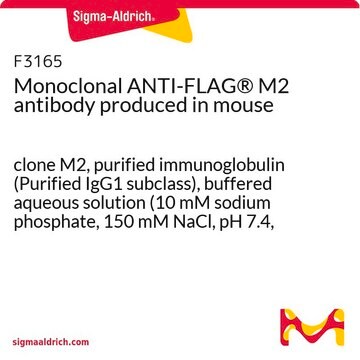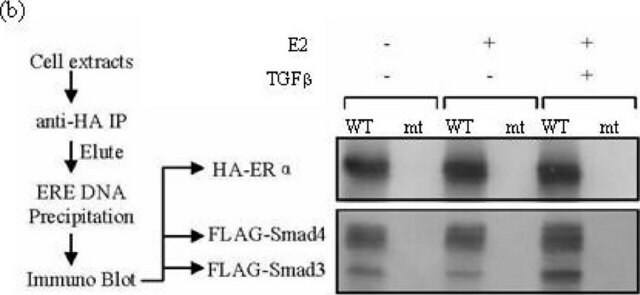11667475001
Roche
Anti-HA-Peroxidase
from mouse IgG2bκ
Sinónimos:
antibody
Iniciar sesiónpara Ver la Fijación de precios por contrato y de la organización
About This Item
Código UNSPSC:
12352200
Productos recomendados
origen biológico
mouse
conjugado
peroxidase conjugate
forma del anticuerpo
purified immunoglobulin
tipo de anticuerpo
primary antibodies
clon
12CA5, monoclonal
Ensayo
≥95% (HPLC and SDS-PAGE)
Formulario
solution
envase
pkg of 50 μg (500 μl)
fabricante / nombre comercial
Roche
concentración
0.1 mg/mL
isotipo
IgG2bκ
secuencia del epítopo
YPYDVPDYA
temp. de almacenamiento
−20°C
Descripción general
Anti-HA-Peroxidase is a monoclonal antibody to the HA peptide, conjugated to peroxidase. Anti-HA-Peroxidase recognizes the HA nonapeptide sequence (YPYDVPDYA), derived from the human influenza virus hemagglutinin protein (amino acids 98-106). The antibody recognizes its antigenic determinant even when the HA peptide epitope is introduced into unrelated recombinant proteins by a technique known as "epitope tagging".
Especificidad
Anti-HA-Peroxidase recognizes the 9-amino acid sequence YPYDVPDYA, derived from the human influenza hemagglutinin (HA) protein. This epitope is also recognized in fusion proteins regardless of its position (N-terminal, C-terminal or internal).
The antibody reacts with the HA epitope, a nonapeptide sequence (YPYDVPDYA) derived from the influenza hemagglutinin protein.
Inmunógeno
Amino acids 98-106 from the human influenza virus hemagglutinin protein
Aplicación
- Use Anti-HA-Peroxidase for the immunochemical detection of native influenza hemagglutinin protein and recombinant HA-tagged proteins using:
- Dot blot
- Western blot
Note: For experiments in which sensitivity is not critical, use Anti-HA-Peroxidase (12CA5). For higher sensitivity detection in western blotting at 10-fold lower concentration, use Anti-HA High Affinity.
Calidad
Each lot of Anti-HA antibody is tested for functionality and purity relative to a reference standard to confirm the quality of each new reagent preparation.
Nota de preparación
Stabilizers: BSA, sucrose, 0.02% thymol
Working concentration: Working concentration of conjugate depends on application and substrate.
The following concentrations should be taken as a guideline:
Working solution: 20-fold dilution of Western Blocking Reagent in 1x PBS.
Working concentration: Working concentration of conjugate depends on application and substrate.
The following concentrations should be taken as a guideline:
- Western blot: 0.1 μg/ml
Working solution: 20-fold dilution of Western Blocking Reagent in 1x PBS.
Otras notas
For life science research only. Not for use in diagnostic procedures.
¿No encuentra el producto adecuado?
Pruebe nuestro Herramienta de selección de productos.
Código de clase de almacenamiento
12 - Non Combustible Liquids
Clase de riesgo para el agua (WGK)
WGK 1
Punto de inflamabilidad (°F)
does not flash
Punto de inflamabilidad (°C)
does not flash
Elija entre una de las versiones más recientes:
¿Ya tiene este producto?
Encuentre la documentación para los productos que ha comprado recientemente en la Biblioteca de documentos.
Los clientes también vieron
Sonia V del Rincón et al.
Oncogene, 23(57), 9269-9279 (2004-11-02)
Insulin receptor substrate-1 (IRS-1) mediates signaling from the insulin-like growth factor type-I receptor. We found that all-trans retinoic acid (RA) decreases IRS-1 protein levels in MCF-7, T47-D, and ZR75.1 breast cancer cells, which are growth arrested by RA, but not
Asvin K K Lakkaraju et al.
Molecular biology of the cell, 23(14), 2712-2722 (2012-06-01)
Mammalian cells secrete a large number of small proteins, but their mode of translocation into the endoplasmic reticulum is not fully understood. Cotranslational translocation was expected to be inefficient due to the small time window for signal sequence recognition by
Marta García-León et al.
The Plant cell, 31(10), 2411-2429 (2019-08-01)
The plant endosomal trafficking pathway controls the abundance of membrane-associated soluble proteins, as shown for abscisic acid (ABA) receptors of the PYRABACTIN RESISTANCE1/PYR1-LIKE/REGULATORY COMPONENTS OF ABA RECEPTORS (PYR/PYL/RCAR) family. ABA receptor targeting for vacuolar degradation occurs through the late endosome
Ryan M Drenan et al.
The Journal of biological chemistry, 281(38), 28222-28231 (2006-07-27)
The RGS7 (R7) family of G protein regulators, Gbeta5, and R7BP form heterotrimeric complexes that potently regulate the kinetics of G protein-coupled receptor signaling. Reversible palmitoylation of R7BP regulates plasma membrane/nuclear shuttling of R7*Gbeta5*R7BP heterotrimers. Here we have investigated mechanisms
Helen Wedegaertner et al.
Molecular biology of the cell, 34(9), ar93-ar93 (2023-05-24)
The α-arrestin ARRDC3 is a recently discovered tumor suppressor in invasive breast cancer that functions as a multifaceted adaptor protein to control protein trafficking and cellular signaling. However, the molecular mechanisms that control ARRDC3 function are unknown. Other arrestins are
Nuestro equipo de científicos tiene experiencia en todas las áreas de investigación: Ciencias de la vida, Ciencia de los materiales, Síntesis química, Cromatografía, Analítica y muchas otras.
Póngase en contacto con el Servicio técnico












